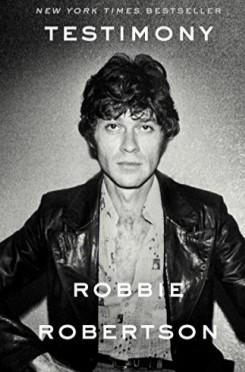Book Review: Robbie Robertson’s “Testimony”

Robbie Robertson had a music band while growing up on the Six Nations Indian Reserve in Canada, but he owes his professional music origins to two guys playing rockabilly and blues covers in the Arkansas Delta region. At age fifteen, Robertson gave two songs he had written to Ronnie Hawkins and the Hawks after his band had opened for a Hawks performance in Canada. Returning to Arkansas, Hawkins recorded these songs for a new album. Hawkins invited his young composer/guitarist discovery to Fayetteville for a crash course in rockabilly guitar playing. A month later, the young Robertson returned to the Canadian city of Toronto, Ontario as the new bass guitarist of the touring Hawks. Along with an Arkansas native and Hawks member, drummer Levon Helm, Robbie was to become the cornerstone of the group called simply The Band.
This music memoir titled Testimony begins with Robertson, Hawkins, Helm, and other Hawk members in two station wagons packed with six people and music gear border crossing between Canada and the American South. When ace guitarist Fred Jones finally departed from the Hawks, Robbie assumed the lead guitarist role. In a short period, multiple band places opened and were filled by serious musicians who became long-term members. Rick Danko, also a Canadian, was brought in for his voice and a promise to assume capably the bass guitar slot. The Hawks took a flyer on another Canadian, piano player Richard Manuel, whose vocals could evoke tears. With the addition of Garth Hudson on Lowry organ in 1981, and the departure of the soloing Ronnie Hawkins, the Hawks personnel now consisted of five committed members, one American and four Canadians. This band would later be renamed The Band.
This group would generally be regarded as a rock band, but Robbie and Levon Helm sought out listening and jamming experiences early with Blues, R&B, and Jazz performers. Bo Diddley in Toronto, John Hammond, Jr. in New York, Muddy Waters, Little Walter and Paul Butterfield in Chicago, Sonny Boy Williamson in Arkansas and Charles Lloyd played influential roles as the Hawks were developing their musical repertoire. “We liked finding obscure records by unknown artists—southern R&B, Chicago blues, rare mountain music… we didn’t have a strong relationship with what was trendy or popular… we would have to make it on our own terms.” The boys deplored playing radio hits.
The author supplies lengthy narrative and dialogue to describe Bob Dylan’s contribution to his career; it was a tumultuous time of transformation for Dylan from folk music hero to playing with a full-blown electric band in 1965. Robbie and his four band mates were recruited by Dylan and Albert Grossman to record and tour, forcing the Hawks to suspend their emergence as a band with their own message. Robbie remembers the experience well—the challenges of working with a demanding leader and initiating the folk traditionalists in audiences from Austin, Texas, to Carnegie Hall in NYC who were trying to boo them off the stage. The perseverance paid off as Grossman delivered many opportunities for performance and recording dates.
Before moving to the West Saugerties of the Catskills Mountains to be closer to Dylan and Grossman, Robertson described a career-expanding period living in the Chelsea Hotel in NYC. Grossman had discovered a deep, soulful singer named Carly Simon and asked Robbie to do her album production work. Concurrently, Dylan had Robbie do the stereo mix for his own new album, Blonde on Blonde. And an artist patron friend named Edie Sedgwick introduced him to luminaries Marlon Brando, Andy Warhol, and Salvador Dali. NYC musicians kept dropping around—street musician Tiny Tim and John, Paul, George and Ringo became his friends. Robertson dedicates two to four book pages to each of these events and personalities; it was a very live period of time in the creative arts world.
At a secluded pink house in the mountains near Woodstock, N.Y., Robbie and Bob Dylan and Richard Manuel wrote music lyrics on typewriters and legal pads before descending to the basement to record the music on tape with the Band. All music genres were included. “Playing music in a circle in the basement or on an acoustic set in the living room was having a big effect on our musical approach: it was about a balance of vocals and instruments. … We had evolved to a place where loud music was like greasy food, not really good for you.” In another inspirational vein, Robbie devoured screenplays bought at the Gotham Book Mart on trips to NYC that were to significantly influence his songwriting. “I was finally able to unlock the storehouse of images in the attic of my memory, all the characters and stories I’d absorbed from the time I was sixteen and arrived in the holy land of rock ‘n’ roll down south… one of the themes that really stuck with me from (Luis) Brunel’s films, like Viridiana, was the impossibility of sainthood—no good deed goes unpunished. I wrote ‘The Weight’ in one sitting that night.”
Robertson, Robbie. Testimony. Crown Archetype: New York. 2016.
# # #
I have written brief reviews of books you can add to the interesting and fun reads of musicians turned memoirists — Willie Nelson, Carlos Santana, Stevie Ray Vaughan, Rev. Gary Davis, Buddy Guy, Lonnie Johnson and others. They managed rock and blues star notoriety and survived to tell the tales of tumultuous change in music history. —Peter R. Furlong, PhD
9(MDA3NDU1Nzc2MDEzMDUxMzY3MzAwNWEzYQ004))
Become a Member
Join the growing family of people who believe that music is essential to our community. Your donation supports the work we do, the programs you count on, and the events you enjoy.
Download the App
Download KUVO's FREE app today! The KUVO Public Radio App allows you to take KUVO's music and news with you anywhere, anytime!